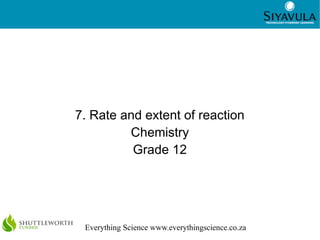
Rate and extent of reaction
- 1. 1 Everything Science www.everythingscience.co.za 7. Rate and extent of reaction Chemistry Grade 12
- 2. 2 Everything Science www.everythingscience.co.za Reaction rate The average rate of a reaction describes how quickly reactants are used, or how quickly products form. The units used are usually moles per second. We can use one of the following two equations to calculate reaction rate (depending on if we have information about the products or about the reactants). Collision theory Reactant particles must collide with the correct energy and orientation for the reactants to change into products. Successful collisions are necessary to break the existing bonds (in the reactants) and form new bonds (in the products). reaction rate= moles product formed reaction time (s) reaction rate= moles reactant used reaction time (s)
- 3. 3 Everything Science www.everythingscience.co.za Factors that affect the average rate of reaction A number of factors can affect the average rate of a reaction. These include: ● Nature of the reactants: Substances have different chemical properties and therefore react differently, and at different rates (e.g. the rusting of iron vs. the tarnishing of silver). ● Concentration of solutions: As the concentration of the reactants increases, so does the reaction rate. ● Surface area of solids: Large lumps of solid reactants have smaller surface areas than powdered solids. ● Pressure of gases: As the pressure of the reactants increase, so does the reaction rate. ● Temperature of the reaction: If the temperature of the reaction increases, so does the average rate of the reaction ● Presence or absence of a catalyst: Adding a catalyst increases the reaction rate by lowering the energy required for a successful reaction to take place. A catalyst speeds up a reaction and is released at the end of the reaction, completely unchanged.
- 4. 4 Everything Science www.everythingscience.co.za Measuring rates of reactions Different methods can be used to measure the average rate of a reaction. The method used will depend on the nature of the product or products. Reactions that produce gases can be measured by collecting the gas in a syringe or by measuring a change in mass of the reaction vessel. In reactions that produce a precipitate the mass of the dried precipitate can be measured. A change in colour can show that the product has formed or that the reaction has reached completion. (This is known as colorimetry).
- 5. 5 Everything Science www.everythingscience.co.za Mechanism of reaction and catalysis For any reaction to occur, a minimum amount of energy is needed so that bonds in the reactants can break, and new bonds can form in the products. The minimum energy that is required is called the activation energy of a reaction. In reactions where the particles do not have enough energy to overcome this activation energy, one of two methods can be used to facilitate a reaction to take place: increase the temperature of the reaction or add a catalyst.
- 6. 6 Everything Science www.everythingscience.co.za Mechanism of reaction contd. Increasing the temperature of a reaction means that the average energy of the reactant particles increases and they are more likely to have enough energy to overcome the activation energy and the chances of two molecules having the correct orientation are increased. A catalyst is used to lower the activation energy so that the reaction is more likely to take place. A catalyst does this by providing an alternative, lower energy pathway for the reaction. A catalyst therefore speeds up a reaction but remains unchanged after the reaction is complete.
- 7. 7 Everything Science www.everythingscience.co.za For more practice see: everythingscience.co.za Shortcode: ESCNC
